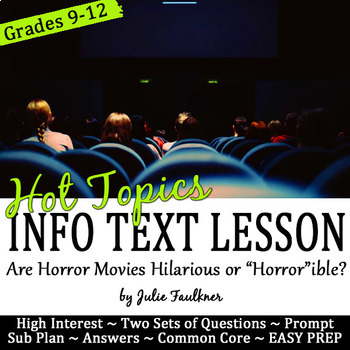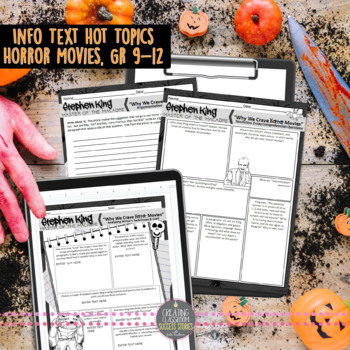Nonfiction Lesson for Halloween: Are Horror Movies Hilarious or Horrible?
- PDF
- Google Apps™

What educators are saying
Description
This hot topics nonfiction mini lesson in print and digital format is the perfect ready-to-go resource to practice close reading skills and comprehension if you are looking for an interesting way to engage students with informational, expository texts this Halloween. This resource is more than just questions and answers - you are getting a full blown mini lesson plan complete with a relevant video link for a starter, an argumentative writing prompt, and spooky creative project... all perfect Halloween activities!
Student Experience: With this intriguing text and topic from the modern master of the macabre himself, your high school students will be engaged, informed, and ready to debate and discuss no matter their reading level or experience with close reading and annotating! Two sets of questions in response to an essay "Why We Crave Horror Movies" by Stephen King are designed to have students truly dig into and respond to a text for comprehension and writer's techniques. Then, your teens will get creative remaking classic texts into horror movies. Last, you can test their understanding with an argumentative writing prompt.
Included:
- Formal lesson plan with standards
- Set with video link (pdf and digital for Google format)
- Background notes (pdf and digital for Google format)
- Links to the text
- Two sets of questions and answers: one for comprehension and one for author's craft (pdf and digital for Google format)
- Argumentative Prompt (pdf and digital for Google format)
- Directions for the creative project
-Super Simple Step by Step Sub Plan Form
More Hot Topics Lessons are just a click away! See these titles:
Are we creating a culture of cheating?
Reading is Good for Your Brain
Do your students struggle with just the basics of close reading and annotating? Do you want them to get more out of a text each time they read? Take a look at my Close Reading and Annotating Complete Teaching Pack to build those basic skills.
Be the first to know about my new discounts, freebies and product launches. Look for the green star next to my store logo and click it to FOLLOW ME. Voila! You will now receive email updates about my store.
For more ideas and inspiration:
Julie's Classroom Stories on Instagram
Julie's Classroom Stories on Facebook
Teaching Middle and High School English Facebook Group
Yearbook and Journalism Facebook Group
Terms of Use: Please one classroom use only. Not to be shared online without proper security. Additional licenses sold at a discount at checkout.




